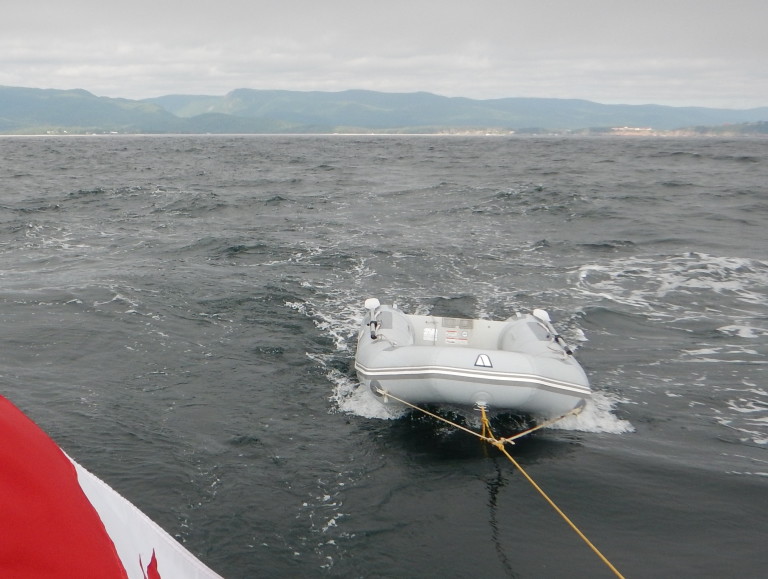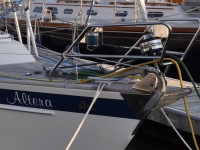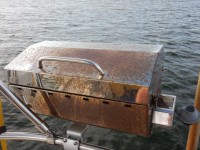The dinghy is probably the one part of cruising that we haven’t found an ideal solution for that works with our boat. For the non-cruisers reading this, you need to understand that the dinghy is analogous to the family car. There are days when it needs to perform like an SUV and other days when a commuter for 1 is just right. It is used daily while out cruising and does a lot more than ferry us ashore in well protected calm anchorages. Unfortunately a dinghy is a huge liability while at sea so one that is ideal once you’ve dropped the anchor often isn’t practical at sea, particularly if you are cruising on a smaller boat like we are.
No two cruisers are alike and we all have different ideas of what is ideal. The dinghy that came with Altera actually worked quite well (although it would have benefitted from a larger diameter tube for extra buoyancy and to keep occupants further from spray). We haven’t found it absolutely necessary to have enough power to get up on plane when the 3 of us are aboard (which is good because our little 5hp wont do that) and don’t regret not upgrading our outboard motor. Although it would be nice on occasions as the dinghy would ride higher and we would stay drier in choppy water or be able to explore further from an anchorage (although often we aren’t time constrained). I will note that we have found the 5hp has the benefit of being light enough to lift on and off by myself and has enough power to plane the dinghy with 1 person for running errands (like going a few miles to refill propane tanks, or get groceries).
As far as the dinghy itself is concerned, I prefer the aluminum bottom dinghy with inflatable tubes as they tend to be lighter than the fibreglass bottom equivalents which makes it much easier to haul up on shore by yourself. This describes what Altera came with which overall was a very decent dinghy and the 9′ length was a good size for two and carried 4 on the few occasions when we had guests.
The problem is transporting the dinghy while sailing. On Georgian Bay we towed our first dinghy almost all the time, the only exception being when we did long hauls, like crossing from Penetang Harbour to Tobermory or the time we ran down from Killarney back to Penetang. On those trips we put in on the bow, upside down. But as you can see it filled the foredeck entirely.
This made it hard to climb over to get to the furler when in port, so I can only imagine what it would be like when rolling around in big waves. The other aspect, is waves can crash on the deck, so a dinghy that size would be subjected to huge forces that could rip it clear of the boat if we got caught in a gale at sea. Ultimately, we decided that even with the tubes deflated it was a little bigger than we wanted for what was going to be our first really big ocean passage.
So, last fall a few weeks before we departed we sold the aluminum hull dinghy and bought a second hand one with an inflatable keel and a slatted aluminum floor (we didn’t want an inflating floor with a dog). We made this decision because we could roll it up and secure it in the v-berth on passage. We knew it was a compromise, but we had our justifications. Our first impressions were favourable. The inflating keel provided a bit of a v-shape on the bow so it did alright in choppy weather, and the extra flex absorbed some of the wave impacts so it was arguably no less comfortable than the old aluminum hull with a more pronounced v-shape. Plus, the tubes were 3 inches bigger diameter meaning we sat higher and stayed drier. And it could carry a bigger payload which proved helpful when we had to lug water in jerry jugs to occasionally fill our water tank. A few sailors said we would regret having sold the RIB, but honestly we knew why we were making the compromise and have been happy enough with it. While we aren’t in a rush to get a bigger motor, another limitation is these dinghies aren’t as stiff, so their horsepower ratings are lower, so when our current outboard finally dies we can’t legally put the Yamaha 2-stroke 9.9 hp on it, which is arguably the most reliable and popular outboard among cruisers.
So where is the actual dilemna, what are we really unsatisified about?
In our travels towing has been fine in the BVI’s, much of Georgian Bay and the Bras d’or Lakes, but a nuissance in the Spanish Virgin Islands, Puerto Rico, parts of the Bahamas and more recently our east coast travels this summer. We’ve had the towing lugs torn off once leading to a capsize and the loss of our oars (plus a tricky recovery), and on more than one occasion in 6-8′ waves we’ve had it surf down a wave from 60′ behind us and bump our stern. Fortunately the towing line floats so we haven’t been in a serious risk of having the line tangle in the rudder, although I wouldn’t rule it out as a possibility. Deflating it every time we sail coastally would be a nuisance, particularly as we need to get Magnus ashore when we arrive anyway or sometimes just to finish anchoring if a shore tie is necessary. This winter, and next summer we are planning routes which will see us spending notably more time in the regions where towing is not a desirable option. Plus towing puts a drag on the boat, is noisy and slows you down, although we’ve only found it to be about a half knot as long as we empty any rain and take the motor off.
Our current dinghy is 4 inches wider than the old aluminum hulled one and doesn’t fit on the foredeck of Altera while inflated. This means we tow it all the time (except on multi-day trips when it goes below) because it needs to be deflated otherwise which is time consuming, particularly when it goes below as it also needs to be dry before I put it on the bed I intend to sleep on the next night.
So what are the criteria and then the options?
Well, the dinghy really needs to hold 4 people. We don’t have guests that often, but when we do this is needed, and when we don’t, we do still occasionally need to cart heavy loads of provisions or water (30 gal of water is about the same as 2 extra people).
The dinghy needs to be able to store down below on passage. I’m not looking for a debate with those who sail offshore with a dinghy on davits, it just simply is not practical on our boat. Likewise, I’ve already covered the size concern for stowing on the foredeck – not an option on our boat – I knew I should have pushed for the 40 footer…
It needs to be able to be launched quickly after a long day of sailing or an over night sail. Magnus is part of this requirement, but some of the interesting cruising grounds we are considering for next summer also require shore tying after you have dropped the hook. It can be difficult to hold Altera straight in swirling winds, so having 1 person man the helm for 20 minutes while the other re-inflates and launches a dinghy and then rows a line ashore is less than desirable.
The dinghy should also be a respectable rower. I enjoy rowing ashore in protected harbours, it is better exercise and saves putting the motor back on.
So…
Obvioulsy we can do nothing, keep the dinghy and keep towing it. If conditions get bad, and it puts Altera in risk, we simply need to be prepared to cut it free and replace it in the next port. If I really liked this option I wouldn’t be writing this post or have spent as much time as I have this summer trying to find a better solution. It is however, the quickest to deploy when it comes to rowing ashore immediately after the anchor is down.
We thought we had struck the perfect idea when we found Winboat, a company in the US that is importing folding RIBs that we could stow below on passage and offer the best ride in choppy conditions, long term durability and accomodate the bigger motor one day. Unfortunately they are too wide to fit on the foredeck of Altera. But this is almost certainly what I will buy if I ever have a bigger cruising boat, as although we could accomodate an inflated RIB on a 40 or 42′ boat, I would still prefer it be down below on passage.
Rigid bottom dinghies with folding transoms appeared to another attractive option although every model we could find either wont fit on the foredeck inflated or can’t be maneuvered onto the v-berth for passages.
We’ve looked at smaller dinghies similar to our current one that will stow below on long passages and fit on the foredeck for overnight jumps or for jumping down the Caribbean island chain. Surprisingly, only found one 1 or 2 that will work. The challenge seems to be, you can easily go shorter to a size that only holds 2 people (will get us very wet on a very regular basis) and not work when we have guests. Otherwise, the slightly shorter dinghies seem to be proportionally wider (presumably so that they can provide the buoyancy to still carry 4 people) which means they wont fit in between the forward lower stays that support the mast, which is probably proving to be the biggest constraint. The model we have found is basically a smaller version of our current one, but the inflating keel provides very little v-shape so it will ride rougher than our current one. Otherwise, the main drawback is I can’t find a second hand one and am reluctant to buy a new one for what is likely just 1 more year of cruising. However, this is the leading option.
We could keep our current dinghy and get a set of davit lifts, or for that matter go full out and get davits, a folding RIB and a bigger motor (unlikely). This has been a topic of discussion for well over a year. While I appreciate the convenience (and the reduction of slime growth on the dinghy), we originally ruled them out as we don’t feel they would be a sea worthy option, particularly on a 34′ boat for ocean passages. Otherwise we would have kept the old dinghy and just installed davits. Plus, Altera is not particularly wide at the transom, so to keep the dinghy clear of waves while heeled over they would need to be tall. This will obstruct our vision from behind. If our boat carried the beam further aft, I would be more inclined to go this route. The other aspect that few people ever talk about with davits is that it is undesirable to put a lot of weight at the ends of the boat. This changes the dynamics of the boat so when you are punching into waves and the bow is going up and down, more weight hanging off the transom can add to the inertia, amplifying the motion of the boat. This is the same reason I don’t have 250′ of chain in the bow locker. So while davits make a lot of sense for a lot of cruisers, we just don’t think they fit our circumstances that well.
So, we are leaning towards accepting the sacrifices of downsizing the dinghy by 10″ for the ability to carry it on the bow. I guess I should really just list our current dinghy for sale and see if I have any takers. That might assist the final decision.




